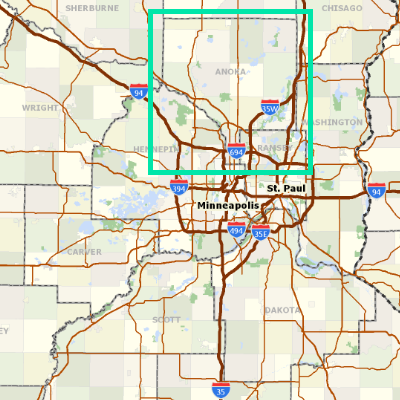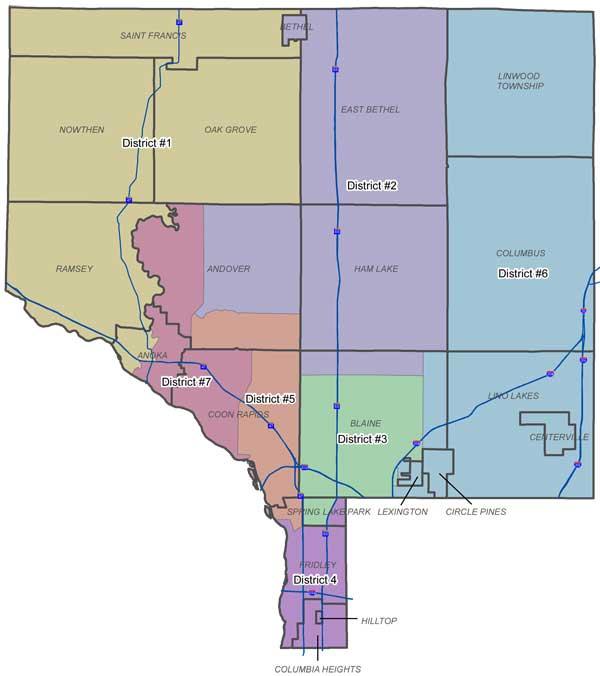Introduction
While working within the community, nurses should address the needs of the community as a diverse group. To discuss the individual health issues, it is necessary to refer to the whole community because the community can affect the health of the local population significantly. Furthermore, to speak about the health services provided within the concrete area, it is necessary to discuss health care delivery at the community level. Anoka County is a county located in the northern part of Minnesota. To understand how to address the community health problems, it is necessary to assess the health of the community in Anoka County. The purpose of this community health assessment is to examine the factors which can influence the health of Anoka County’s population and to propose recommendations to address the community’s health needs. Thus, to assess the community’s health, it is necessary to develop and analyze the Anoka County community profile data, to conduct the windshield survey to assess the community needs, interpret the data, prioritize the needs, and provide the recommendations for the community on how to address the community’s health needs.
Discussion of the Community’s Location
Anoka County is a highly-populated county located in the northern part of Minnesota. The county borders on Chisago County, Hennepin County, Ramsey County, Washington County, Isanti County, and Sherburne County (Anoka County Website, 2014; Appendix 1). Regarding such a dimension as the community’s location, it is important to pay attention to such characteristics as the presence of many water resources and adequate water supplies to meet the community’s needs. The mild climate, flora, and fauna are typical for Minnesota State and this region of the country. Thus, the absence of pestilent plants prevents the community from additional non-typical health risks. The majority of the community’s population lives in urban areas. However, in spite of the typically mild weather, the community is at risk of frequent tornados, hurricanes, and storms because of the climate features (Anoka County Website, 2014). That is why much attention should be paid to the disaster emergency activities in the county in order to provide people with the necessary health assistance when disasters occur (Table 1).
Table 1. Anoka County Location and Geography.
While referring to the environmental controls and human-made environment, it is important to note that the community focuses on realizing effective waste management strategies, and the water and soil resources are not polluted with the substances such as Cadmium, Chromium, and Lead which are harmful to the people’s health. According to the report on the community’s water supplies, it is important to state that the community does not suffer from the lack of water resources, and the water supplies can be discussed as appropriate in relation to the quality of the used water (Anoka County Website, 2014). The community also does not suffer from the problem of air pollution because of the low use of transport and industry development. Thus, the data on air pollution provides the information that the air pollution in the community is lower than the average rate in the state according to the stated norms (Table 2). As a result, representatives of the community demonstrate a low rate in relation to respiratory diseases.
While focusing on the types of housing and overall conditions, it is necessary to note that the majority of the population living in the community (more than 70%) occupies their own and rented houses built during the 1980s-1990s. However, there are also buildings built in 1939 and earlier. The reported household conditions do not influence the health of the community directly. The main problem associated with providing health care services for the community is in the fact that there are only two hospitals in Anoka County which can provide specialized assistance (Anoka County Website, 2014; Table 2). There are about one hundred health care clinics in the community, but the delivery of the health care services is not appropriate because of the necessity to respond to many patients’ needs on a daily basis.
Table 2. Environment Controls, Human-Made Environment, and Location of Health Services.
Anoka Population Features
The size of Anoka County’s population is about 340,000 people, and the community is mostly urban. The community is not very populous, but its density is high. That is why, there are almost one hundred health care clinics in the community, but only two hospitals. The median age in the community is about 37 years which is why most services are proposed for the middle-aged population (Figure 1; Table 3).
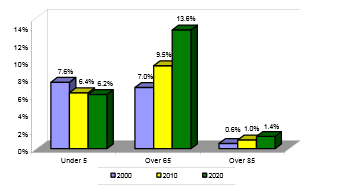
Females and males are presented equally in the community, and the majority of them are married. Thus, the community focuses is satisfying the families’ needs and proposes many health care services for women and children. Cultural differences do not affect the provision of health care directly because the majority of the population is white, and other races are only 10% of the population (Figure 2; Table 3).

It is also important to note that the community is constantly growing, the birth rate is double the number of deaths, and the people’s need for high-quality care increases. The leading causes of mortality are cancer and heart disease for persons aged 45-more years, and unintentional injury is the leading cause for persons aged 1-more years (Figure 3; Table 3).
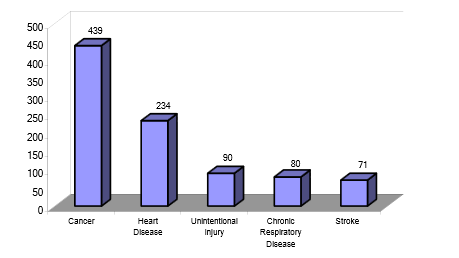
The community can be discussed as highly mobile because many community members are migrant workers, and many persons drive every day to work in the other community. This fact influences the availability of health care services positively.
The majority of the community can be discussed as belonging to middle-class families. The level of poverty in the community is about 7% for the elder population and children, it is rather high and demonstrates that many persons suffer from financial hardships. That is why, the community proposes a range of services for elder people and children in need which are housing assistance, child support, and health programs. The unemployment level is comparably high, the community representatives mostly work in small businesses, occupy office and management positions, work in retailing and construction. More than 25% of the community’s population has a bachelor’s degree (Anoka County Community Health Assessment Report 2010-2014, 2010). As a result, the community members’ employment level does not contribute to receiving the regular income and insurance to support their health status in spite of the educational status and other factors (Table 3).
Table 3. Anoka Population.
The lack of insurance, financial resources, and education in the sphere of health and social protection leads to such problems as the low nutritional value of food and development of associated diseases. That is why, more than 60% of the community’s population suffers from obesity and overweight (Anoka County Website, 2014; Figure 4).

While referring to such a health care problem as tobacco use, it is important to note that there is a tendency to give up smoking observed among the community’s adult population. However, the rate of smokers is still more than 17%, and it is significantly higher than the average country’s rate (Anoka County Website, 2014; Figure 5).
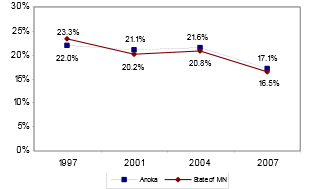
Anoka County Social System
Having analyzed the aspects of the social system in Anoka County according to the windshield survey and community profile, it is important to note that educational, recreational, and daycare facilities are adequate, and they respond to the community’s needs. Seven school districts and two colleges are able to cope with the flow of students. All the community members have the access to libraries (Figure 6). The number of gymnasiums, playgrounds, sports yards, and parks is large, and the community members have opportunities for recreation (Table 4). The number of nursing homes, kindergartens, and social homes respond to the current needs of the community in relation to the average number of single persons and families within the community (Anoka County Website, 2014; Table 4). There are also many resources to address the needs of the community members as citizens and followers of religious movements. Cultural and religious differences are addressed and respected.
Table 4. Anoka County Social System.
However, the community’s members suffer from inappropriate provision of services and health care delivery because of lacks in the transportation system. Thus, many persons use their own cars to access hospitals and service centers (Anoka County Website, 2014). In contrast, the community’s safety is supported according to the range of social programs developed to address the emergency issues, health care promotion, waste management, and social assistance issues. Poverty and housing problems are addressed in the community with the help of social local and state programs. Nevertheless, more attention should be paid to educating adolescents about the risks of tobacco and alcohol use (Anoka County Website, 2014). Inadequate amount of healthcare facilities in the community is one of the most critical challenges. There are many clinics and healthcare providers in Anoka County, but they are rather difficult to access for persons from suburbs and rural territories (Figure 6). In spite of the fact that two community hospitals have resources to provide services for all the community, many community members have no opportunity to use these services because of transportation and health issues.
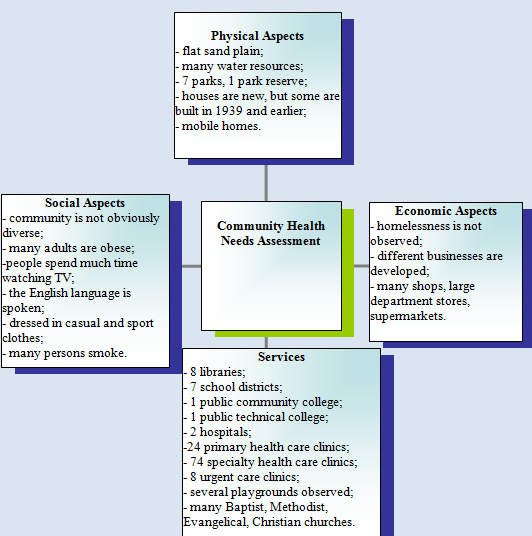
Analysis of the Community’s Annual Report
According to the Anoka County Health Assessment Report of 2010, the community continues to provide effective health care services for the population, but the problem is in the fact that the number of community members is constantly increasing, but the existing resources are not improved and changed to address the needs of the community. The report provides important information on the location of the community stating that Anoka County presents perfect opportunities for the people’s recreational activities. The community’s environments are discussed as contributing to supporting the population’s health (Anoka County Community Health Assessment Report 2010-2014, 2010; Appendix 2).
The report analyzes the population of the community in detail. It is noted that males and females living in the community often die from lung cancer and injuries. However, the birth rate is high in comparison with the death rate. Furthermore, the birth rate increased in relation to ethnic minority families (Anoka County Community Health Assessment Report 2010-2014, 2010). Referring to the information presented in the report on the social system, it is important to note that many adults suffer from a lack of access to health care services. Although there are many opportunities for recreational activities, many people do not use these resources and suffer from the lack of physical activities. Poor nutrition is discussed as the cause of obesity and overweight (Anoka County Community Health Assessment Report 2010-2014, 2010). As it is stated in the report, housing and transportation issues influence the community directly because of limiting the opportunities to receive assistance.
Community Health Needs and Problems
The collected and analyzed community data provide a lot of information to determine what health needs and problems are critical for the community of Anoka County. A range of needs and problems were identified as a result of conducting the windshield survey and examining the community’s official reports. To receive the true picture of the health problems in Anoka County, it is necessary to organize the list of the identified health problems according to such prioritization criteria as the prevalence of the problem according to the local and state statistical data, percentage of the reported cases associated with the problem, and the community members’ perception. The identified problems were analyzed and prioritized according to the mentioned criteria. The first stated problem is identified as the most critical for the community:
- obesity and overweight among adults and children;
- active tobacco use;
- lack of access to health care services;
- alcohol use;
- lack of insurance;
- lack of the physical activities;
- stress.
The rationale for prioritizations depends on the appropriateness of the chosen criteria. To state the problem, it is necessary to refer to mentions of the problem in different types of credible resources. The local and state statistical data provide much information about the population’s unhealthy eating habits and their diseases associated with obesity and overweight, lack of physical activity, and tobacco use (Allender, Rector, & Warner, 2014, p. 464). There is a lot of reported information on the community members’ alcohol use and felt pressure associated with the impossibility to access health care services, to find a job, and to receive medical insurance (Anoka County Website, 2014; Entwistle, Firnigl, & Ryan, 2012, p. 70; Kit, Simon, Brody, & Akinbami, 2013, p. 407). These data are also supported by the windshield survey’s results on the community’s health and community members’ perception of their status.
The Community Health Diagnoses
While referring to the assessed data and identified health problems and needs, it is necessary to formulate the community health diagnoses depending on such community’s top health problems as obesity and overweight, lack of physical activities, and tobacco use (Mirzaei & Aspin, 2013, p. 251; Rath, Villanti, Abrams, & Vallone, 2012, p. 134; Tovar, Chui, & Hyatt, 2012, p. 102). From this point, the community health diagnoses can be formulated the following way:
- The residents of Anoka County in Minnesota are at risk of developing chronic diseases, heart diseases, and diabetes because of unhealthy eating habits, obesity, and overweight, poor nutrition, and lack of knowledge in this sphere of care;
- The community members are at risk of lung cancer, chronic respiratory diseases, and asthma because of smoking habits;
- The community members are at risk of injuries and developing chronic, severe, and acute illnesses because of the limited access to the health care services.
Recommendations for the Community
To develop effective recommendations for the community to overcome the problem of obesity and overweight, extensive tobacco use, and improve health care delivery, it is necessary to refer to the goals and objectives proposed by the government in the Healthy People 2020 program. The Healthy People 2020 goal associated with the problem of obesity and overweight is the following one: “Promote health and reduce chronic disease risk through the consumption of healthful diets and achievement and maintenance of healthy body weights” (HealthyPeople.gov, 2014). The program goal associated with tobacco use is formulated the following way: “Reduce illness, disability, and death related to tobacco use and secondhand smoke exposure” (HealthyPeople.gov, 2014). In addition, Healthy People 2020 provides the goal connected with accessing health care services: “Improve access to comprehensive, quality health care services” (HealthyPeople.gov, 2014).
Referring to the above-mentioned goals, it is possible to formulate the recommendations for the community of Anoka County:
- Reduce the risk of chronic diseases associated with obesity and overweight:
- Improve the community members’ knowledge of healthy eating habits;
- Promote the access to fresh and nutritional products;
- Increase the residents’ interest in physical activities;
- Contribute to the persons’ consumption of healthy food.
- Reduce the rates of such illnesses like lung cancer, chronic respiratory diseases, and asthma associated with tobacco use:
- Promote smoking cessation among adults;
- Improve the knowledge of tobacco use risks among children;
- Develop anti-smoking campaigns.
- Improve the public health care infrastructure:
- Improve the access to health care services;
- Overcome the problem of limiting access;
- Promote high-quality health care services.
Conclusion
The population of Anoka County faces a lot of challenges associated with such host and environmental factors like the lack of the developed health care infrastructure to respond to the needs of all the community members, the lack of knowledge in the spheres of healthy eating and physical activities, the lack of education in relation to the problem of tobacco use. As a result, the community health diagnoses are based on the idea that the community’s residents are at risk of chronic diseases because of unhealthy eating habits; they are at risk of lung cancer, chronic respiratory diseases, and asthma because of tobacco use; and they are at risk of injuries and chronic, severe, and acute illnesses because of the limited access to the health care services.
References
Allender, J.A., Rector, C., & Warner, K.D. (2014). Community health nursing: Promoting and protecting the public’s health. Philadelphia, PA: Lippincott, Williams, and Wilkins.
American Psychological Association. (2010). Publication manual of the American Psychological Association. Washington DC: Author.
Anoka County Community Health Assessment Report 2010-2014. (2010). Web.
Anoka County Website. (2014). Web.
Entwistle, V., Firnigl, D., & Ryan, M. (2012). Which experiences of health care delivery matter to service users and why? A critical interpretive synthesis and conceptual map. JHSRP, 17(2), 70-78.
HealthyPeople.gov. (2014). Web.
Kit, B., Simon, A., Brody, D., & Akinbami, L. (2013). US prevalence and trends in tobacco smoke exposure among children and adolescents with asthma. Pediatrics, 131(3), 407-414.
Mirzaei, M., & Aspin, C. (2013). A patient-centered approach to health service delivery: improving health outcomes for people with chronic illness. BMC, 13(2), 251-263.
Rath, J., Villanti, A., Abrams, D., & Vallone, D. (2012). Patterns of tobacco use and dual-use in US young adults: the missing link between youth prevention and adult cessation. JEPH, 679(1), 134-142.
Tovar, A., Chui, K., & Hyatt, R. (2012). Healthy-lifestyle behaviors associated with overweight and obesity in US rural children. BMC Pediatrics, 12(6), 102-110.
Appendix 1
